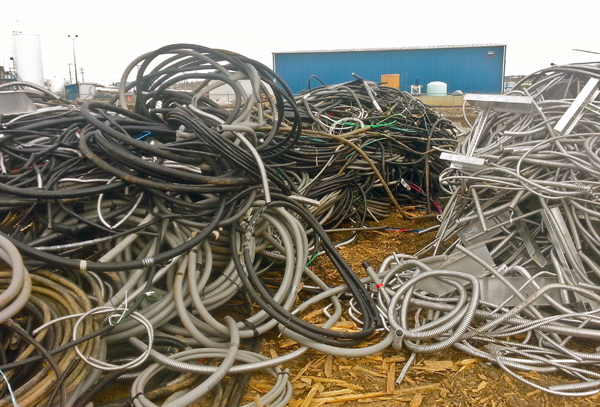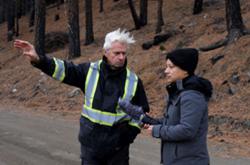[Editor's note: Every day this week we're featuring reports from Christopher Pollon's quest to follow a pound of B.C. copper from cradle to grave -- and back again. Today he takes a detour to a metal salvage yard in the heart of BC's North Eastern oil patch. To get a sense of the scope of the project, see this interactive map and introductory story.]
FORT ST. JOHN, B.C. -- The stretch of Highway 97 in the northeastern B.C. Interior between Dawson Creek and Fort St. John is an odd place for a two-kilometre traffic jam -- until you consider that this roadway straddles a resource boom.
Gregg Drury is idling his pick-up on a July morning amid logging trucks, oil field suppliers and RVs, trying to get to the metal salvage yard he operates for ABC Recycling near Fort St. John. He's doing a huge business these days buying all the metal discarded from old farms, local residents, and more than anything else, the oil patch.
"They're generating incredible amounts of waste up here," he says. "From pipelines, I get all that steel, but when they tear a plant down for instance, there's lots of aluminum, stainless steel, and excess copper and wire."
The metal salvage yard buys thousands of pounds of copper each day. It's a tiny part of the business by volume, but huge in dollar value. Steel fetches about eight cents a pound, aluminum about 40 cents; copper, anywhere from $2 to 2.40.
Drury is both a newcomer and anomaly to the metal recycling business. In a past life he was a wilderness tourism guide who co-founded a tiny environmental group in B.C.'s remote northwest to sound the alarm about the potential impacts of mining the province's nascent copper belt. He has seen first-hand the effect of copper mining on big rivers, and considers his latest career a chance to be part of a solution.
"When we've already expended enormous resources to harvest copper from the earth's crust, it only makes sense to use it as many times as we possibly can," he says. "In my tenure here, if I can divert 10 to 20 million pounds of waste metal back into productive use, then that's something real."
Recycling is mining
ABC's Fort St. John operation buys copper by the pound, bales it up and trucks it to Vancouver, where it's sold to downstream recycling companies and metal smelters all over the world. Like the raw ore mined in places like Copper Mountain near Princeton, much of this raw material leaves British Columbia on ships destined for Asia.
Instead of digging open pits, recycling businesses scour urban and industrial landscapes for reusable metals. But the commodity they produce ultimately competes in the same global marketplace as companies mining virgin ore, sharing their windfalls and misfortunes.
The difference is, reusing scrap metal negates many of the environmental liabilities inherent in digging raw ore from the earth. Take copper: much of the world's remaining supply is present only in tiny concentrations, necessitating moving of mountains of often acid-generating rock. The energy needed for this is immense. Depending on the metal and form of the scrap, recycling a kilogram takes between one-tenth and one-twentieth of the energy needed to mine and refine a kilogram of virgin ore.
Coal provides the primary energy of choice in many of the world's copper mining operations -- the vast quantities of greenhouse gases it emits not only stokes climate change, but is also likely to become an increasing financial cost for those mines, as many countries move toward putting a price on carbon emissions.
These liabilities are often presented as necessary tradeoffs we all make to enjoy a high standard of living. Citizens of the developed world are all complicit. And there is no better example than copper: it is an indispensible ingredient in almost everything associated with a comfortable middle class lifestyle. Modern housing, lighting, transportation, communications and electronics -- none could exist without copper.
And considering that less than half -- an estimated global average of 45 per cent -- of all the copper scrapped at the end of its useful service life between 2000 and 2010 was recycled, with the rest lost to landfills and dumps, why not just ramp up recycling and minimize the number of open pit mines and all their impacts?
Immense risks from 'tough ore'
Copper is a finite resource: current estimates suggest there is at least 100 years of virgin supply left, with production peaking by about mid-century even if copper is more abundant than geologists think. Like oil, most high grade, easy-to-access ore bodies have already been tapped, meaning that miners will increasingly need to go to ever more remote, costlier, and difficult locations, exposing and crushing more rock from vaster pits, all to extract ever lower grades of ore. (Or ever-expand the footprint of existing mines.)
Proposals to develop the Pebble mine in Alaska, or KSM in northern B.C. -- both huge, very low-grade copper deposits posing immense risks to the world's best salmon waters -- could only have emerged in this era of "tough ore."
The approaching limit of an even more basic resource, water, thwarts attempts to bring some of the richest remaining copper deposits into production. Chile produces one-third of the world's copper, but the energy costs of mining there have risen seven-fold over the last decade, in part because its mines require enormous volumes of scarce fresh water. A plan is in the works to make it mandatory for miners to desalinate and pipe ocean water to arid regions high above sea level. Nearly $40-billion worth of Chilean mining projects (most of them for copper) have recently been stalled due to high anticipated costs and environmental issues.
No cakewalk for global recycling either
Today, about 30 per cent of all copper consumed in the world comes from recycled metal. This has been enabled by China's hunger for scrap as a source of raw material, historically high global prices, and the fact that unlike plastic and paper, scrap copper does not degrade upon successive reuse. An atom of recycled copper from a discarded cell phone, water pipe or car radiator, is indistinguishable from an atom of virgin ore freshly dug up at the Copper Mountain mine.
It's often said that most of the copper ever mined has been continually recycled for thousands of years. But in fact more recent scrutiny has found that on average an atom of copper is used less than twice (just 1.9 times) before it is disposed of.
Serious challenges confront efforts to recycle more metals. Compared to large-scale virgin minerals processing underwritten by historically low energy prices, most recycling is local, labour intensive, and smaller in scale. According to Barbara Reck, a research scientist and metals expert at Yale University's School of Forestry and Environmental Studies, it is often difficult to attract the investment needed to scale up operations with available "sense and sort technologies." "Much otherwise recoverable material is lost," she writes.
And even though copper is by its physical nature readily recyclable, enormous amounts of it are locked up for decades at a time -- in our buildings, transportation systems and cars.
How much copper will the world need?
The International Copper Study Group concluded in 2010 "recycled copper alone cannot meet society's needs, so we also rely on copper produced from the processing of mineral ores."
China currently consumes over 40 per cent of all the copper the world produces, and thus remains the wild card in questions of future demand. If Chinese incomes continue to rise, and the government is successful in transforming China into an urbanized nation hooked on consumer goods, the present levels of combined production of recycled and virgin copper (and many other commodities) will not be enough.
"Barring a technological revolution of substantial scale, the world is arguably facing seemingly insurmountable constraints across the whole gamut of commodities," writes Dambisa Moyo in Winner Take All. Moyo notes this commodity crunch will include arable land, energy and other minerals, in particular copper, if China continues to flourish.
Assuming that China's copper consumption continues to grow faster than the rest of the world's in coming decades, the planet faces a global copper deficit by 2030. That, at any rate, is what resource analysts at Wood Mackenzie foresee if new virgin copper deposits are not brought into production.
If bullish predictions of growth stall, metal salvage and recycling could emerge as growth industries by necessity. In 2011, journalists Chris Hedges and Joe Sacco travelled through abandoned sections of America ("sacrifice zones," as they called them), and repeatedly found that metal salvage operations were among the only viable businesses left after the crash of local economies -- outside of drug dealing and street level prostitution.
On the same track, author and social critic James Kunstler predicts modern mining, with its dependence on increasing amounts of energy to tap shrinking grades of minerals, will grind to a halt as energy costs escalate. After that, a true recycling society will be forced on all of us whether we choose it or not.
"I expect many suburbs [in the future] will become squats, ruins, and salvage yards," said Kunstler in a 2011 interview. "Out of necessity, we will have to forage and reuse all kinds of materials that were energy-intensive to make, from aluminum trusses to concrete blocks." ![]()
Read more: Energy, Labour + Industry


















Tyee Commenting Guidelines
Comments that violate guidelines risk being deleted, and violations may result in a temporary or permanent user ban. Maintain the spirit of good conversation to stay in the discussion.
*Please note The Tyee is not a forum for spreading misinformation about COVID-19, denying its existence or minimizing its risk to public health.
Do:
Do not: